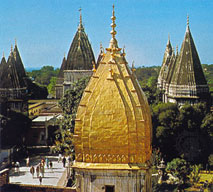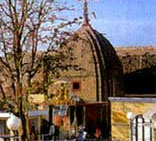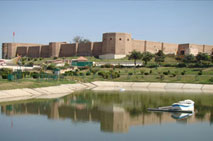ABOUT JAMMU:

Nestling in the foothills of the Himalayas, with the
river Tawi flowing alongside, due to many temples built here it is
also known as city of temples. The main credit to populate this
place goes to King Jambulochan.
Jammu is the gateway of J&K situated on the bank of river Tawi, it
is the place that Raja Jambu Lochan discovered one day while he was
on a hunting trip. Legend has it that he came upon a clearing where
he saw a sight that left him wonderstruck. A tiger and a goat stood
side-by-side, drinking water from the same place in the Tawi River.
He was so struck by this unusual sight that he decided to build a
city on this land where no living creature seemed to bear enmity
towards each other. Earlier its name was Jambupura which became
Jammu later.
The history of dogra king prevails in the living habits of people of
Jammu. In 1730 it became the capital of king Dhruvdeva, from that
period till the freedom of India dogra rulers prevailed here.
From the point of view of art, culture and history, Jammu has
special importance. This city is the main centre of attraction for
trade. Here dogri language is spoken. No doubt this is the Gateway
of whole state of j&K, still Hindi, Kashmiri; Punjabi, Urdu and
English are spoken here.
Location: 305-km from Srinagar, J&K
Significance: The Winter capital & Second Largest Town in the State
of Jammu & Kashmir.
Languages Spoken: Dogri, Hindi, English, Urdu, Kashmiri & Punjabi.
Best Time to Visit: September to April
Places to Visit:
Raghunath Mandir : Amongst the temples in Jammu, the Raghunath Mandir
takes pride of place being situated right in the heart of the city.
It consists of a cluster of temples and is the largest temple
complex in northern India. Its inner sanctums contain gigantic
statues of deities and numerous 'lingams'. It contains
representatives of almost the entire Hindu pantheon, which make it a
rare site to behold.
Bawey Wali Mata Temple :
The famous temple of Bawey Wali Mata is
inside the Bahu Fort where, every Tuesday and Sunday, pilgrims
throng to worship the goddess. It is said that if the Bawey Wali
Mata is the presiding deity of Jammu, a little further away, on a
spur opposite the Bahu Fort, overlooking the river Tawi, stands a
temple dedicated to Mahamaya, a Dogra heroine who lost her life
fourteen centuries ago fighting foreign invaders. The Peer Kho cave
temple overlooking the Tawi River, the Panchbakhtar temple and the
Ranbireshwar temple are the other well known Shiva temples in Jammu.
Other important temples in Jammu are the Lakshmi Narayan temple,
Duda Dhari temple and the Panj Mandir in Gandhi Nagar. The 'durgah'
of Peer Budhan Ali Shah or Peer Baba as it is known, is the shrine
that protects the people of this city from mishaps and evil spirits.
Bahu Fort & Gardens :
Situated 5 kms away from the city centre, Bahu
Fort stands on a rock face on the left bank of the river Tawi.
Perhaps the oldest fort and edifice in the city, it was constructed
originally by Raja Bahulochan over 3,000 years ago.
The existing fort was more recently improved upon and extended by
the Dogra rulers. Inside, there is a temple dedicated to the Hindu
goddess Kali. An extensive terraced garden, known as Bagh-e-Bahu,
has been developed around the fort. The subcontinent's largest
underground aquarium in Jammu's Bagh-I-Bahu area is drawing a large
number of tourists ever since it was opened to the public, The
aquarium-cum-awareness centre comprises of 24 aquarium caves
including 13 small caves for holding freshwater fishes
Ranbir Canal :
A small garden along the Ranbir Canal, which runs
through the city outskirts, provides a cool picnic spot during the
summer. The canal branches off from the river Chenab at Akhnoor, 32
kms away. Its water remains icy-cold throughout the year and its
banks serve as good viewpoints and walkways

